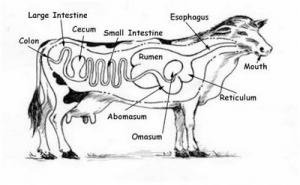Structure of the digestive system
How does a cow's digestive system work?

Answer:
Cattle have one stomach with four compartments. These compartments are the rumen, reticulum, omasum, and abomasum, with the rumen being the largest compartment. Cattle are ruminants, meaning that they have a digestive system that allows use of otherwise indigestible foods by repeatedly regurgitating and re-chewing them as "cud". The cud is then re-swallowed and further digested by specialized microorganisms in the rumen.
The rumen is where fermentation occurs, and where the initial process of digestion occurs after the forage is swallowed whole. Fermentation is achieved by the microbial activity in the rumen, which enables the "decomposition" of cellulose, fibre, and carbohydrates into volatile fatty acids. Microbes in the rumen are also able to synthesize amino acids from non-protein nitrogenous sources like urea, ammonia. The microbes that die off also provide the individual cattle-beast a source of protein and energy.
Cattle sometimes consume foreign objects which are deposited in the reticulum. For this reason, the reticulum is known as the "hardware stomach." The metal, if it doesn't penetrate the reticulo-rumen wall, will stay in the reticulum and break down from the cow's gastric juices. If a cow gets ill from these foreign objects puncturing the stomach lining, often a magnet is given orally to the cow to collect all these metal objects and keep them in one place.
The omasum's main function is to absorb water and some nutrients from the digesta, and is known as the "many plies," since the skin-lining in the omasum is layered, much like the pages of a book, to allow for more surface area to absorb more moisture from the digesta that entered the omasum from the rumen.
The abomasum functions like the human stomach; this is why it is known as the "true stomach". It secretes protein and starch digesting enzymes to further digest the digesta that wasn't digested in the rumen.
After the digesta has undergone the necessary digestion from the stomach, it goes through more nutrient absorption through the small intestine. When it enters the large intestine, the digesta is pretty well considered waste. More water absorption occurs, and the waste reaches the rectum, which is then expelled as feces.
The rumen is where fermentation occurs, and where the initial process of digestion occurs after the forage is swallowed whole. Fermentation is achieved by the microbial activity in the rumen, which enables the "decomposition" of cellulose, fibre, and carbohydrates into volatile fatty acids. Microbes in the rumen are also able to synthesize amino acids from non-protein nitrogenous sources like urea, ammonia. The microbes that die off also provide the individual cattle-beast a source of protein and energy.
Cattle sometimes consume foreign objects which are deposited in the reticulum. For this reason, the reticulum is known as the "hardware stomach." The metal, if it doesn't penetrate the reticulo-rumen wall, will stay in the reticulum and break down from the cow's gastric juices. If a cow gets ill from these foreign objects puncturing the stomach lining, often a magnet is given orally to the cow to collect all these metal objects and keep them in one place.
The omasum's main function is to absorb water and some nutrients from the digesta, and is known as the "many plies," since the skin-lining in the omasum is layered, much like the pages of a book, to allow for more surface area to absorb more moisture from the digesta that entered the omasum from the rumen.
The abomasum functions like the human stomach; this is why it is known as the "true stomach". It secretes protein and starch digesting enzymes to further digest the digesta that wasn't digested in the rumen.
After the digesta has undergone the necessary digestion from the stomach, it goes through more nutrient absorption through the small intestine. When it enters the large intestine, the digesta is pretty well considered waste. More water absorption occurs, and the waste reaches the rectum, which is then expelled as feces.
Source: wiki.answers.com
User Comments
Other article






















